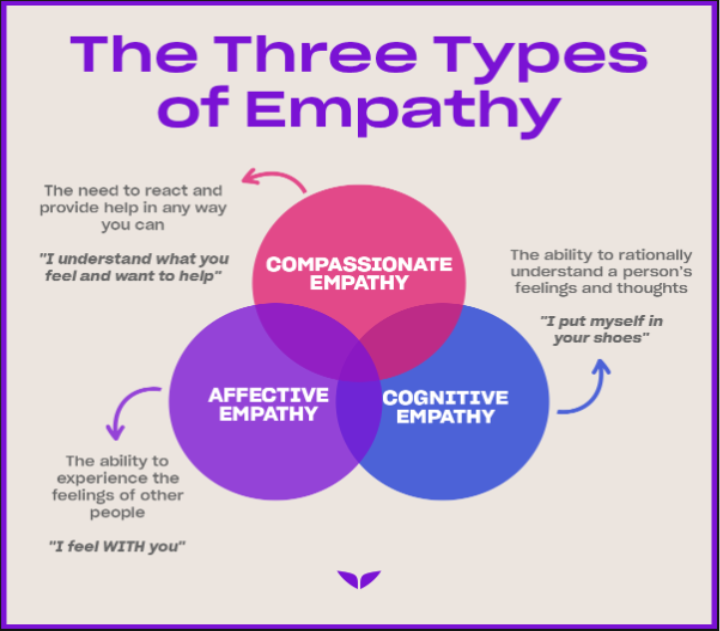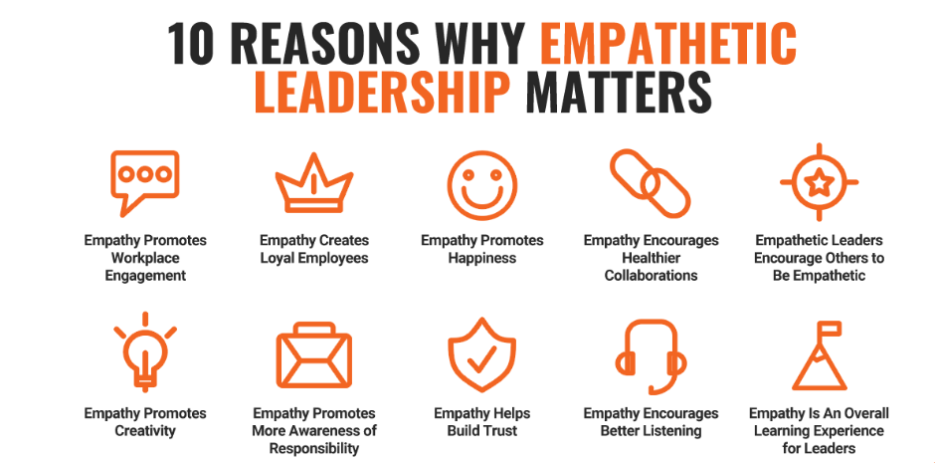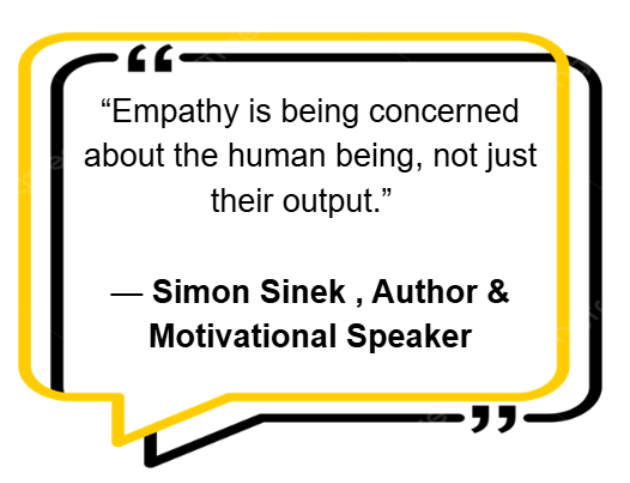Leadership and Team Effectiveness
Empathetic Leadership: Definition, Benefits, Pitfalls & Practice in Today’s Workplace (With Indian Context)

.png)
Written by
Aarohi Parakh,
Psychologist and Content Writer

Reviewed by
Sanjana Sivaram,
Psychologist and Clinical Content Head

Introduction
Imagine a product team in Bengaluru, mid-launch. Deadlines are tight, and everyone’s drained. The delivery manager pauses the sprint and asks, “How’s everyone really doing this week?” A junior engineer shares she’s grieving a recent loss; another mentions unstable internet on demo days. The manager listens, arranges temporary bandwidth support, pairs the engineer with a buddy, and resets expectations. The result? The product ships on time — without burning people out.
That’s empathetic leadership: not “soft” sentiment, but practical choices that protect people and outcomes. Across India’s startups, IT hubs, factories, and family-run firms, leaders who understand human realities keep teams loyal, resilient, and creative.
This article offers a clear, research-backed guide — what empathy is, why it matters, key traits of empathetic leaders, real Indian examples, common pitfalls, and a practical toolkit with scripts, KPIs, and FAQs you can use for training or reflection.
What Is Empathy & Empathetic Leadership?
Empathy is the skill of entering another person’s experience, seeing their perspective, feeling a part of what they feel, and responding appropriately. It is not a pity, and it’s not simply an agreement. In leadership, empathy becomes an active practice of attention and response.
Types of Empathy
Different types of empathy help us connect with people in various ways at the workplace.
- Cognitive empathy —understanding another’s perspective.
Example: A senior manager in a BPO acknowledges that day-shift employees caring for elderly parents experience unique off-duty pressures compared to night-shift colleagues and thoughtfully adapts to expectations during festival seasons to support their well-being.
- Emotional/Affective empathy — feeling with someone.
Example: A team lead in a factory senses the collective fatigue on the floor after a demanding order cycle and genuinely acknowledges it in a town hall, emphasising permission to breathe and recover.
- Compassionate/Action empathy — acting to help.
Example: After the loss of a fellow employee, an HR head recognises the team’s emotional strain and provides additional mental health support and compassionate leave, turning empathy into meaningful support.
Empathetic leadership binds these together: leaders perceive, feel, and act in ways that protect psychological safety and sustain performance. It’s practical — quick check-ins, clear boundaries, purposeful flexibility — not endless accommodation

Why It Matters — Backed by Research
A 2025 systematic review (Springer) grouped the benefits of empathetic leadership in organisations into nine categories. Here’s what each means in practice, with short, direct implications for Indian workplaces.
- Better Emotional Well-Being
When leaders create space for emotions and provide support, employees report lower stress, more energy, and easier recovery after setbacks. In practice, this reduces sick leave and increases day-to-day focus.
- Improved Team Relationships
Empathy strengthens mutual respect. Teams that practise empathy communicate better, hand off work more smoothly, and avoid the resentment that derails projects.
- Higher Trust Levels
Employees trust leaders who listen and act. Trust reduces the need for micromanagement, speeds decisions, and frees managers to focus on strategy.
- Reduced Conflicts
Many workplace disputes start with misunderstandings. Empathetic leadership reduces escalation by catching and addressing friction early.
- Increased Inclusion
When leaders seek and respect diverse perspectives, underrepresented voices (women, first-generation college graduates, and regional language speakers) feel included — increasing retention and broadening the talent pool.
- Better Decision-Making
Empathy adds human context to data. Decisions that factor in people’s realities are less likely to backfire and more likely to succeed in the long run.
- Higher Employee Engagement
People who feel seen go beyond transactional effort; they offer discretionary energy (mentorship, extra problem-solving, and advocacy) that drives outcomes.
- Improved Innovation
Psychologically safe, empathetic teams test ideas without fear—the willingness to experiment fuels creative products and improved processes.
- Lower Burnout Rates
When leaders monitor workload and emotional load, burnout declines. Lower burnout improves retention, a huge cost saver in high-churn sectors like IT and startups.
Workplace surveys consistently confirm this relationship: employees report higher morale and retention in empathetic work environments. In India’s hybrid, high-pressure workplaces, empathy is a defensive and offensive strategy: it protects people and amplifies performance.
Key Traits of Empathetic Leaders
Great empathetic leaders share observable skills and habits. Each trait below includes examples and practical ways to develop it.
Active Listening (not just pretending)
- What it looks like: Try using language that mirrors what the speaker is sharing instead of multitasking and other distractions.
- How to practise: Schedule five-minute “start-of-meeting” check-ins and deliberately reflect on what you heard. Example: “I’m hearing that the timeline feels tight because of X and Y. Is that right?”
Inclusive Perspective-Taking
- What it looks like: Soliciting input from quiet team members and rotating meeting chairs to spotlight different voices.
- How to practise: At least once a quarter, explicitly invite junior perspectives in a non-evaluative environment. In India, this can mean inviting employees from different states to share how policies affect them.
Open Communication (with safe channels)
- What it looks like: Transparent reasoning for decisions and regular two-way updates.
- How to practise: Publish simple weekly team notes summarising wins, challenges, and what leaders learnt. Use anonymous pulse surveys for candid feedback.
Recognition & Appreciation (beyond trophies)
- What it looks like: Acknowledging effort publicly and privately, and crediting teams rather than individuals for wins.
- How to practise: Add a “micro-win” slot to weekly meetings: two lines of appreciation per person.
Support for Growth (mentorship + opportunities)
- What it looks like: Regular career-focused conversations, opportunities to work on visible or high-impact projects, and access to small learning or upskilling budgets.
- How to practise: Schedule a 20-minute quarterly conversation with each team member, centred on their long-term career aspirations rather than just immediate performance.

Benefits in Practice: Examples
Empathetic leadership is not just a concept; it delivers tangible results when applied consistently. Research, including the 2025 Springer review, identifies 9 key areas in which empathy improves workplace outcomes. Below, each area is paired with actionable insights and real Indian case examples to illustrate its impact.
Emotional Well-being
Empathy directly influences how employees feel day to day. Leaders who actively listen and validate emotions help reduce stress and anxiety.
- Case Example – Pune Hospital: During the second wave of COVID-19, nurses and doctors faced extreme pressure. The Chief Medical Officer implemented daily 10-minute empathy huddles where staff could voice concerns and receive emotional support. Burnout reports dropped by 30%, improving morale and overall service quality.
- Takeaway: Short, consistent opportunities for employees to express feelings can drastically improve mental health and reduce absenteeism.
Team Relationships
Empathy strengthens collaboration by fostering mutual respect and understanding among team members.
- Case Example – Mumbai Fintech Startup: Rotating “shadow days” allows engineers to observe customer support workflows. This experiential perspective-taking improved handoffs, reduced miscommunication, and created a culture of shared responsibility.
- Takeaway: Encouraging employees to understand each other’s roles improves trust and cohesion across teams.
Trust Levels
Trust is the foundation of high-functioning teams. Leaders who listen, act reasonably, and maintain transparency build employee confidence.
- Case Example – Delhi Family-Owned Business: By personally engaging with employees’ concerns during hierarchical decision-making, the leadership maintained loyalty across generations. Employees trusted leadership to act in their best interest, reducing attrition and improving engagement.
- Takeaway: Demonstrating genuine concern for employees’ perspectives strengthens long-term organisational commitment.
Conflict Reduction
Early empathy intervention reduces friction before it escalates into disputes.
- Case Example – Chennai Manufacturing Plant: Managers conducted listening sessions with workers to understand commuting and family challenges. By adjusting shifts and providing temporary travel allowances, recurring conflicts over attendance and productivity were minimised.
- Takeaway: Proactive understanding and accommodation can prevent conflicts and maintain smooth operations.
Inclusion
Empathetic leaders recognise and embrace diverse perspectives, fostering an inclusive workplace culture.
- Case Example – Delhi Private School: Teachers struggled with hybrid learning during the pandemic. Weekly empathy forums allow them to voice challenges and contribute ideas for resource allocation and lesson planning. The school implemented these suggestions, boosting teacher engagement and student satisfaction.
- Takeaway: Actively seeking input from all levels ensures underrepresented voices are heard and valued.
Better Decision-Making
Leaders who factor human realities into decision-making make more balanced and sustainable choices.
- Case Example: A Hyderabad startup layered empathy checks into product planning, with teams considering how new features would affect customer support staff workloads. This prevented last-minute crises and operational stress, allowing smoother project execution.
- Takeaway: Including employees’ perspectives leads to more practical, ethical, and effective decisions.
Higher Employee Engagement
When employees feel understood, they bring discretionary effort, creativity, and loyalty to the organisation.
- Case Example – Bengaluru IT Firm: Weekly “chai chats” and micro check-ins create psychological safety. Team members were more willing to take ownership of projects and contribute ideas, significantly increasing engagement scores within three months.
- Takeaway: Simple, empathetic interactions increase motivation and discretionary performance.
Improved Innovation
Empathy fosters psychological safety, encouraging experimentation and creative problem-solving.
- Case Example – Mumbai Creative Studio: Leaders held “no-blame brainstorming” sessions, making employees comfortable sharing half-formed ideas. This approach led to three new client campaigns in a single quarter, a clear demonstration of empathy driving innovation.
- Takeaway: Safe, empathetic spaces unlock creativity and allow risk-taking without fear of judgement.
Lower Burnout Rates
Empathetic leaders actively monitor workload, emotional well-being, and work-life balance, preventing chronic stress.
- Case Example – Pune Hospital & Chennai Manufacturing Plant: Both organisations implemented empathy-driven policies: mental health support in hospitals and flexible shifts in manufacturing. These interventions reduced burnout, improved retention, and enhanced long-term productivity.
- Takeaway: Empathy-driven practices reduce stress, preserve energy, and protect organisational knowledge by retaining skilled employees.
Across industries, from IT and fintech to manufacturing, healthcare, and education, empathetic leadership drives measurable outcomes. Leaders who integrate empathy into daily practices see improved well-being, stronger relationships, greater trust, inclusion, better decision-making, greater engagement, innovation, and reduced burnout. These benefits are amplified in India, where cultural collectivism, hierarchical workplaces, and family-centric values make human connection especially impactful.

The Other Side — Pitfalls & Real Solutions
Empathy is powerful, but if misapplied, it can create unintended challenges. Leaders often face these pitfalls when the balance between compassion and boundaries is lost.
- Pitfall 1: Empathy Fatigue: When leaders take on everyone else’s stress without outlets, they start feeling emotionally drained, irritable, or detached. This is a common risk in people-intensive roles.
Fix: Rotate emotional labour — use HR, peer coaches, and EAPs; schedule regular leader downtime and reflective supervision.
- Pitfall 2: Perceived Weakness / Exploitation: Sometimes empathy gets misread as unlimited leniency. Employees may test boundaries, deadlines slip, and accountability fades.
Fix: Pair empathy with clear, consistent accountability. Use written agreements for flexibility (e.g., temporary work-hour adjustments with milestone check-ins).
- Pitfall 3: Inconsistent Empathy / Favouritism: When leaders extend extra understanding to some but not all, others notice quickly. Perceptions of resentment or “special treatment” emerge.
Fix: Apply standard checks (who had a check-in this week? who received support?) and anonymised audits to ensure fairness.
- Pitfall 4: Decision Paralysis: Endless consultations in the name of “being empathetic” can stall urgent choices, leaving teams confused and frustrated.
Fix: Adopt a decision rule: gather necessary human input in X hours, then make the call and communicate the rationale.
Implementing Empathetic Leadership: A Practical Toolkit
Empathy becomes real when it shows up in everyday routines. Here are a few ways to make it part of your daily leadership:
Scripts & Questions (for 1:1s)
Don't just provide task updates when you check in with your team. "What's going well, and what's draining you right now?" is a good question to try, or "What sort of assistance would enable you to accomplish this goal without experiencing burnout?" These enquiries demonstrate that you place equal importance on wellbeing and performance, not one at the expense of the other.
Weekly Meeting Format (12 minutes)
Make sure your team meetings are brief but impactful. After a brief personal check-in, discuss updates and blockers, acknowledge a few small victories, and conclude with a clear next step. That way, meetings stay efficient but still leave space for human connection.
Role-Play Exercise (30 minutes)
Want to build empathy muscles? Try a simple reflective listening exercise. Pair up — one person shares a real stress scenario, and the other listens before suggesting one supportive action. Then switch roles. It’s a great way to notice when we jump too quickly into “fix-it” mode instead of acknowledging emotions first.
Policies & Practices
Empathy isn’t only about tone; it’s also about systems. Even a small flexibility policy — with clear expectations and timelines — can lower stress during busy periods. And don’t forget to keep mental health resources visible in team updates, so people know help is available without feeling singled out.
Measurement & KPIs
Check if your empathy efforts are landing. Mix short-term signals, such as a quick “I feel heard” pulse survey, with longer-term ones, such as attrition rates or 360° reviews that include empathy-specific feedback.
Day-in-the-Life Checklist
Anchor empathy in your routine. Start with a short team huddle, make time for one or two personal one-to-ones, act on feedback before the day ends, and take a minute to note someone you appreciated. Over time, these small rituals build a culture where care feels consistent — not performative.
Indian Context & Geo-Relevance
- IT & Startups
Empathy is crucial for retention in high-churn and hybrid work environments; micro-supports (flexible sprints, connectivity allowances) are also important.
- Manufacturing & Plants
Empathy manifests as scheduling flexibility and safety investments; shift work and physical stress necessitate a visible leader presence.
- Family Businesses & MSMEs
Empathy balances family dynamics with professional governance; clear communication prevents role confusion.
- Public Sector
Where bureaucracy rules, empathetic leaders who listen to ground realities can improve morale and service delivery.
Across sectors, popular Indian practices such as micro-breaks, festival recognition, and family-inclusive policies are powerful empathy levers when used intentionally.
Quote Section

FAQs
Q1. Is empathy a natural trait or a skill leaders can build?
Both. Although empathy is a skill that can be learnt, some people are born with it. Leaders can cultivate empathy habits by participating in structured feedback loops, perspective exercises, and active listening training. When culturally sensitive training considers language use, family priorities, and festival cycles, empathy becomes more authentic in Indian contexts.
Q2. How can I strike a balance between empathy and business targets?
Consider empathy as an investment rather than a compromise. Long-term losses from attrition and burnout are avoided with short-term accommodations (temporary role swaps, flexible deadlines). To align empathy with results, use KPI check-ins and written agreements.
Q3. How can organisations scale empathy beyond a few leaders?
Embed empathy in systems: make it a criterion in performance reviews, include empathy training in manager onboarding, and measure employee-perceived manager support. Peer mentoring and empathy champions foster diffusion beyond formal training.
Q4. What quick wins can a manager try this week?
Start with 10-minute “get real” check-ins, add one micro-recognition per meeting, and send one short note thanking a team member—small actions compound.
Q5. How to measure empathy’s impact?
Use a combination of pulse surveys (feeling heard), retention metrics, and qualitative narratives—track changes in OOO leave, sick days, and reports of interpersonal conflict. Qualitative stories (like the Mumbai startup’s chai chats) show impact in human terms.
Conclusion — A Call to Practical Empathy
Empathy isn’t just an HR slogan — it’s what keeps workplaces human and effective. In India’s fast-changing work culture, empathetic leadership turns daily challenges into real strengths. Start small, listen often, track what works, and balance care with clarity. Leaders who do that don’t just build better teams — they create workplaces that last.
References
- Thriveworks. (n.d.). Types of empathy: Emotional, cognitive, and compassionate empathy. Thriveworks. https://thriveworks.com/help-with/feelings-emotions/types-of-empathy/
- Center for Creative Leadership. (2021). Empathy in the workplace: A tool for effective leadership. CCL. https://www.ccl.org/articles/leading-effectively-articles/empathy-in-the-workplace-a-tool-for-effective-leadership/
- Hello Monday. (2022). The art of leading with empathy, kindness, and heart. Hello Monday. https://www.hellomonday.co/blog-posts/the-art-of-leading-with-empathy-leading-with-kindness-and-leading-with-heart
- Harvard Division of Continuing Education. (2023). Building empathetic leadership. Harvard Professional Development. https://professional.dce.harvard.edu/blog/building-empathetic-leadership/
- Payactiv. (2023). Empathetic leadership in the workplace: What it means and why it matters. Payactiv. https://www.payactiv.com/blog2/empathetic-leadership-in-workplace/
- Tony Robbins. (2023). Empathetic leadership style: How to lead with understanding. Tony Robbins. https://www.tonyrobbins.com/what-is-leadership/empathetic-leadership-style
- Emeritus. (2024). Empathetic leadership: Why emotional intelligence matters. Emeritus. https://emeritus.org/in/learn/empathetic-leadership/
- Universitat Oberta de Catalunya. (2024). Empathic leadership: A key skill to inspire and motivate teams. Blogs UOC. https://blogs.uoc.edu/mel/empathic-leadership-a-key-skill-to-inspire-and-motivate-teams/
- Springer. (2024). Empathy and its effects on leadership: A systematic review of empirical studies. Journal of Business Economics, 94(2), 411–436. https://link.springer.com/article/10.1007/s11301-024-00472-7
- Thakur, N., & Kumar, P. (2024). Empathetic leadership and employee engagement in the post-pandemic era. International Journal of Advanced Research in Science, Communication and Technology (IJARSCT), 4(2), 1093–1101. https://www.ijarsct.co.in/Paper19162.pdf
- Harvard Business Review. (2025, April). Empathy is a non-negotiable leadership skill: Here’s how to practice it. Harvard Business Review. https://hbr.org/2025/04/empathy-is-a-non-negotiable-leadership-skill-heres-how-to-practice-it
- National Center for Biotechnology Information (NCBI). (2025). Empathy in leadership: A systematic review and conceptual framework. Frontiers in Psychology, 16, 1–18. https://pmc.ncbi.nlm.nih.gov/articles/PMC11150825/










